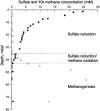Stratified communities of active Archaea in deep marine subsurface sediments
- PMID: 16820449
- PMCID: PMC1489303
- DOI: 10.1128/AEM.00562-06
Stratified communities of active Archaea in deep marine subsurface sediments
Abstract
Archaeal 16S rRNA was extracted from samples of deep marine subsurface sediments from Peru Margin site 1227, Ocean Drilling Program leg 201. The amounts of archaeal 16S rRNA in each extract were quantified by serial dilution and reverse transcription (RT)-PCR. The results indicated a 1,000-fold variation in rRNA content with depth in the sediment, with the highest concentrations found near the sediment surface and in the sulfate-methane transition zone (SMTZ). The phylogenetic composition of the active archaeal population revealed by cloning and sequencing of RT-PCR products changed with depth. Several phylotypes affiliated with marine benthic group B (MBGB) dominated clone libraries from the upper part of the SMTZ and were detected only in this layer. Members of the miscellaneous crenarchaeotal group (MCG) dominated clone libraries from the other layers. These results demonstrate that archaeal communities change in activity and community composition over short distances in geochemically distinct zones of deep subseafloor sediments and that these changes are traceable in the rRNA pool. It was shown for the first time that members of both the MCG and MBGB Archaea are more active in the SMTZ than in layers above and below. This indicates that they benefit either directly or indirectly from the anaerobic oxidation of methane. They also appear to be ecophysiologically flexible, as they have been retrieved from a wide range of marine sediments of various geochemical properties.
Figures





References
-
- Biddle, J. F., J. S. Lipp, M. A. Lever, K. G. Lloyd, K. B. Sørensen, R. Anderson, H. F. Fredricks, M. Elvert, T. J. Kelly, D. P. Schrag, M. L. Sogin, J. E. Brenchley, A. Teske, C. H. House, and K.-U. Hinrichs. 2006. Heterotrophic Archaea dominate sedimentary subsurface ecosystems off Peru. Proc. Natl. Acad. Sci. USA 103:3846-3851. - PMC - PubMed
-
- Boetius, A., K. Ravenschlag, C. J. Schubert, D. Rickert, F. Widdel, A. Gieseke, R. Amann, B. B. Jorgensen, U. Witte, and O. Pfannkuche. 2000. A marine microbial consortium apparently mediating anaerobic oxidation of methane. Nature 407:623-626. - PubMed
-
- Chao, A. 1984. Non-parametric estimation of the number of classes in a population. Scand. J. Statist. 11:265-270.
Publication types
MeSH terms
Substances
Associated data
- Actions
- Actions
- Actions
- Actions
- Actions
- Actions
- Actions
- Actions
- Actions
- Actions
- Actions
- Actions
- Actions
- Actions
- Actions
- Actions
- Actions
- Actions
- Actions
- Actions
- Actions
- Actions
- Actions
- Actions
- Actions
- Actions
- Actions
- Actions
- Actions
- Actions
- Actions
- Actions
- Actions
- Actions
- Actions
- Actions
- Actions
- Actions
- Actions
- Actions
- Actions
- Actions
- Actions
- Actions
- Actions
- Actions
- Actions
- Actions
- Actions
LinkOut - more resources
Full Text Sources
Molecular Biology Databases

